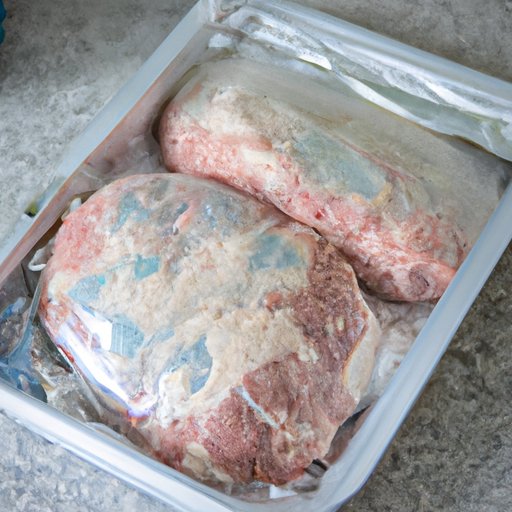
Introduction
Picture this – you take a pack of frozen meat out of the freezer and leave it on your kitchen countertop to thaw. A few hours later, you get busy with work and forget all about it. When you finally remember, you find the meat already wet and with an odd smell. At this point, you’re unsure of what to do with it. Can you refreeze it?
In this article, we’ll be exploring whether it’s safe to refreeze meat thawed at room temperature. We’ll be separating fact from fiction and providing expert advice on how to handle thawed meat to minimize health risks.
The Truth About Refreezing Meat: Separating Fact from Fiction
There are several misconceptions surrounding refreezing meat, with some people arguing that it’s completely safe, while others believing that it’s dangerous and can lead to food poisoning. So, what’s the truth?
Contrary to popular belief, the process of refreezing meat, in itself, isn’t dangerous. However, the problem lies in how the meat is handled before and after thawing. This means that handling practices are crucial in determining whether it’s safe to refreeze meat.
According to the United States Department of Agriculture (USDA), you can refreeze meat that has been thawed in the refrigerator, in cold water, or in the microwave. However, meat that was thawed at room temperature shouldn’t be refrozen, as it’s already in the danger zone where bacteria can grow at a rapid pace.
What Happens When You Refreeze Meat Thawed at Room Temperature?
If you refreeze meat that has been thawed at room temperature, you expose yourself and anyone who consumes the meat to several risks, including bacterial growth and food poisoning. Here’s what happens:
1. Explanation of the effects of improper handling: When you leave meat to thaw at room temperature, the exterior thaws first, creating a moist and warm environment that’s perfect for bacterial growth. This allows bacteria to spread to the interior of the meat, rendering it unsafe for consumption.
2. How bacteria can grow and spread: As bacteria grow and spread on the thawing meat, they produce toxins that can cause severe food poisoning symptoms such as diarrhea, vomiting, and fever.
3. Risks associated with eating refrozen meat: When you refreeze meat that has been thawed at room temperature, you trap the bacteria and toxins within the meat. This means that when you later thaw and cook the meat, you won’t kill the bacteria, which could lead to severe illness if consumed.
Understanding the Risks of Refreezing Meat and How to Safely Handle It
Indeed, the best approach to handling thawed meat is to try and avoid refreezing altogether. However, in some instances, refreezing might be the only option. That’s why it’s important to follow the following guidelines:
1. Guidelines for safe thawing and handling of meat: Always thaw meat in the refrigerator, in cold water, or in the microwave. If you choose to thaw your meat in cold water or the microwave, you need to cook it immediately to avoid bacterial growth.
2. Importance of temperature control: Ensure that you keep thawed meat at a safe temperature (below 40°F) before cooking to minimize bacterial growth. Also, ensure that you cook the meat at the recommended internal temperature to kill all the bacteria.
3. Best practices for refreezing meat: If you need to refreeze meat, it’s recommended that you do so as soon as possible after thawing it. In addition, ensure that you use a freezer-safe container and place the meat at the back of the freezer to minimize temperature fluctuations.
Expert Advice on Refreezing Meat: What You Need to Know
It’s always helpful to get advice from food safety experts on how to handle thawed meat. Here’s what they have to say:
1. Insights from food safety experts: According to the USDA, you can safely refreeze meat that has been thawed in the refrigerator or in cold water, provided that it has been handled correctly throughout the process.
2. Tips for minimizing risks when refreezing meat: One of the easiest ways to reduce health risks is to ensure that you keep your kitchen clean and sanitize all surfaces that come into contact with raw meat. This will minimize the spread of bacteria.
3. Resources for further information: For more information on how to handle food safely, visit the USDA’s website or consult with your local health department for guidelines specific to your location.
Don’t Make These Mistakes: How to Properly Handle Thawed Meat
Even with the guidelines in place, it’s still possible to make mistakes when dealing with thawed meat. Here are some common mistakes to avoid:
1. Common mistakes to avoid when handling thawed meat: Avoid leaving meat to thaw on the countertop at room temperature, and don’t refreeze meat that was thawed at room temperature.
2. How to properly store meat to prevent spoilage: Always store meat in airtight containers or freezer bags, and label the containers with the date to ensure that you use the oldest ones first.
3. Tips for safe thawing and refreezing: Always thaw meat in the refrigerator or in cold water, and use a thermometer to ensure that you cook it to the correct temperature to kill all bacteria.
Conclusion
Refreezing meat that was thawed at room temperature is a risky practice that could lead to severe food poisoning. However, if you follow the guidelines and handle your meat correctly, you can minimize these risks and safely handle your meat.
Remember, food safety is not something to take lightly. Take steps to ensure that you handle your thawed meat safely to protect yourself and your loved ones from potentially harmful bacteria.




